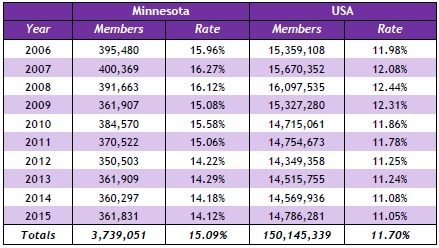Unionization in Minnesota is higher than the national average, at 14.2 percent. Veterans are among the most unionized groups in the state (21.2 percent). Unions raise wages by 11 percent and help close the racial gap in Minnesota.
This report is the fifth in a five-part series on the “State of the Unions” for Illinois, Indiana, Iowa, Minnesota, and Wisconsin. All five reports are available at this link.
A new study released today finds that organized labor still plays a considerable role in Minnesota’s economy, despite a decline of approximately 34,000 union members over the past decade.
The study, The State of the Unions 2016: A Profile of Unionization in Minneapolis, in Minnesota, and in America [PDF] was conducted by researchers at the Midwest Economic Policy Institute, the Carlson School of Management’s Labor Education Service at the University of Minnesota, and the Project for Middle Class Renewal at the University of Illinois at Urbana-Champaign.

As of 2015, the overall union membership rate is 14.2 percent in Minnesota:
- The number of union members has increased by about 11,000 since 2012.
- White, non-Latino workers are more likely to be unionized (15.0 percent) than non-white workers (9.8 percent) in the state.
- Veterans are among the most unionized socioeconomic groups in Minnesota (21.2 percent).
- By educational attainment, the most unionized workers in Minnesota hold Master’s degrees (31.0 percent).

Minnesota has a higher unionization rate than the national average. Over half of all public sector workers are unionized in Minnesota and the Twin Cities metropolitan area, while only one-third of public sector workers are unionized across the nation. However, fewer than one-in-ten (8.0 percent) Minnesotans who work in the private sector are union members.
Labor unions increase individual incomes by lifting hourly wages – particularly for low-income and middle-class workers. In Minnesota, unions raise worker wages by an average of 11.1 percent. The state’s union wage effect is the 11th-highest in the nation. The union wage differential is higher for the median worker (13.6 percent) than the richest 10 percent of workers (11.0 percent), helping to foster a strong middle class and reduce income inequality.
Unions also help to close the racial income gap in the state. On average, unions increase the wages of white workers by 10.3 percent but boost the hourly earnings of non-white workers by 17.3 percent. Unions are one of the most effective anti-poverty institutions in Minnesota.

Unions play a vital role in Minnesota’s economy and communities. The Minnesota labor movement, however, will continue to face both short- and long-term challenges. Labor’s response to these challenges could define its influence and effectiveness in the decades to come.
For more:
- (2016) The State of the Unions 2016: A Profile of Unionization in the Twin Cities, in Minnesota, and in America can be found here.
- (2016) The State of the Unions 2016: A Profile of Unionization in Chicago, in Illinois, and in America can be found here.
- (2016) The State of the Unions 2016: A Profile of Unionization in Indianapolis, in Indiana, and in America can be found here.
- (2016) The State of the Unions 2016: A Profile of Unionization in in Iowa and America can be found here.
- (2015) From ’15 to $15: the State of the Unions in California and its Key Cities in 2015 – California report.
- (2015) The State of the Unions 2015: A Profile of Organized Labor in New York City, New York State, and the United States – New York report.
Visit ILEPI at www.illinoisepi.org, like ILEPI on Facebook, and follow ILEPI on Twitter @IllinoisEPI.
